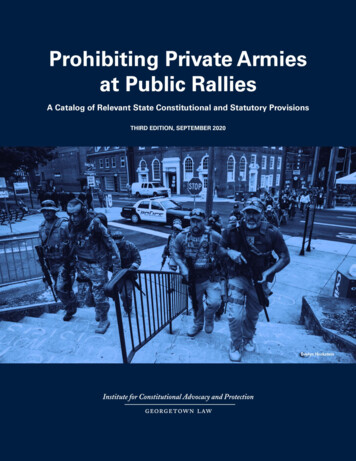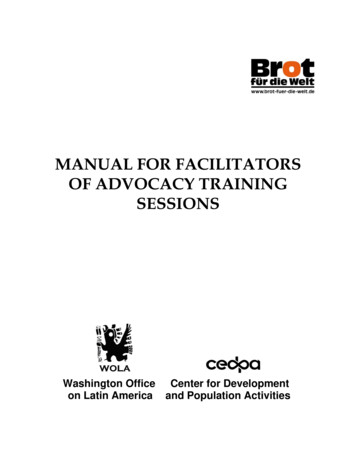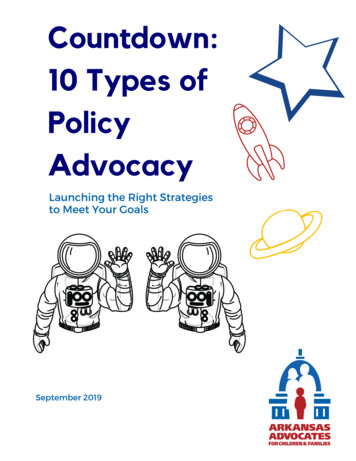
Transcription
1 Institute for Constitutional Advocacy & Protection
Table of ContentsExecutive Summary . 1Background . 1Findings . 2Summary Chart: State Constitutional and Statutory ProvisionsRelated to Paramilitary Activity . 9State-by-State Constitutional and Statutory Provisions Related toParamilitary Activity . 17Alabama . 17Alaska . 19Arizona. 20Arkansas . 21California . 23Colorado . 25Connecticut. 27Delaware . 29Florida . 30Georgia . 32Hawaii . 34Idaho . 35Illinois . 39Indiana . 41Iowa . 42Kansas . 43Kentucky . 44Louisiana. 45Maine . 46Maryland . 49Massachusetts . 50Michigan . 51Minnesota . 54Mississippi . 56Prohibiting Private Armies at Public Rallies i
Missouri . 57Montana . 59Nebraska . 60Nevada . 61New Hampshire . 62New Jersey . 63New Mexico . 64New York . 67North Carolina . 70North Dakota . 72Ohio . 73Oklahoma . 74Oregon. 76Pennsylvania . 78Rhode Island . 80South Carolina . 82South Dakota . 83Tennessee . 84Texas . 86Utah . 87Vermont . 88Virginia . 89Washington . 92West Virginia . 94Wisconsin. 95Wyoming . 96ii Institute for Constitutional Advocacy & Protection
Executive SummaryBackgroundThe pitched, battle-like atmosphere and tragic violence at the Unite the Right rally inCharlottesville, Virginia, on August 12, 2017, marked a turning point in this country and caused grief andalarm nationwide. Touted as an opportunity to protest the removal of a controversial Confederatestatue, the event quickly escalated well beyond such constitutionally protected expression. Instead,private military forces transformed the college town into a virtual combat zone.Several white nationalist groups arrived outfitted in helmets and matching uniforms anddeployed shields, batons, clubs, and flagpoles as weapons in skirmishes with counter-protesters that theinstigating groups coordinated under centralized command structures. Meanwhile, private militiagroups—many dressed in camouflage fatigues, tactical vests, helmets, and combat boots, and mostbearing assault rifles—stood guard as self-designated protectors of the protesters and counterprotesters. The heavily armed presence and coordinated paramilitary activities of all of these groups notonly increased the prevalence of violence at the rally, but also made it more dangerous for state and locallaw enforcement to maintain public safety. Moreover, the attire and behavior of some of the selfprofessed militia led to confusion as to who was authorized to lawfully keep the peace.On October 12, 2017, Georgetown University Law Center’s Institute for Constitutional Advocacyand Protection (ICAP), along with local counsel, filed suit on behalf of the City of Charlottesville, localbusinesses, and neighborhood associations in order to prevent these self-proclaimed militias and certainwhite nationalist groups from returning to Virginia and engaging in prohibited paramilitary conduct. Thelawsuit alleged that the defendants violated key provisions of Virginia constitutional and statutory lawthat protect against private armies and paramilitary activity—laws intended to reinforce the fundamentaltenet of civil society that the government must maintain a monopoly on the legitimate use of force forthe protection of public safety. These laws prohibit the kind of disorder and chaos that occurred at theUnite the Right rally. ICAP’s lawsuit drew on historical precedent: in the 1980s, relying on the anti-militiaprovisions of Texas and North Carolina law, private plaintiffs successfully brought suits to prevent thelocal militia wings of the Ku Klux Klan from using paramilitary tactics against minority groups.1 And it wassuccessful, resulting in court orders permanently enjoining the defendants from returning toCharlottesville as part of a group of two or more people acting in concert while armed with any itemwhose purpose is for use as a weapon during any rally, protest, demonstration, or march.This report identifies state constitutional provisions and/or statutory prohibitions that targetsimilar private military and paramilitary conduct in each of the 50 states. Although the lawsuit filed inCharlottesville sought injunctive relief as an important tool for preventing a repeat of the unlawfulparamilitary activity engaged in by the defendants in Virginia, these state laws also can be usedproactively by localities across the country as a basis for lawful time, place, and manner restrictionsdesigned to minimize violence at future rallies. Consistent with that approach, in October 2017 ICAPconsulted with authorities in the cities of Murfreesboro and Shelbyville, Tennessee, to help them preparefor “White Lives Matter” rallies organized by the League of the South in their public spaces. ICAP helped1See Vietnamese Fishermen’s Ass’n v. Knights of the Ku Klux Klan, 543 F. Supp. 198 (S.D. Tex. 1982); Person v. Miller,854 F.2d 656 (4th Cir. 1988).Prohibiting Private Armies at Public Rallies 1
these cities to identify and incorporate relevant Tennessee anti-paramilitary-activity laws into their eventpermits and conditions in a manner consistent with the First and Second Amendments to the U.S.Constitution. The Shelbyville rally concluded without significant violence and only one arrest; theMurfreesboro rally, planned for later the same day, was called off by its organizers entirely.Since the Unite the Right rally, ICAP has consulted with numerous localities across the country,large and small, seeking to protect public safety while preserving constitutional rights. More recently, asprotests against police brutality and racial injustice have spread in the wake of the killing of George Floyd,ICAP has consulted with concerned residents and activists who increasingly have reported that theirpeaceful marches and vigils have been met with intimidating militia members bearing assault rifles,dressed in military gear, and often shouting down their messages while purporting to be there to “keepthe peace” or “protect” property. This usurpation of legitimate law enforcement and military functions isin violation of law in all 50 states, and dramatically increases the risk of violence during First Amendmentprotected activity.FindingsThis report identifies, for each of the 50 states, the constitutional and statutory provisionsrelevant to paramilitary and private militia activity. Importantly, each state has at least one constitutionalor statutory provision that applies to the type of paramilitary and private militia activity that may arise atfuture rallies similar to the Unite the Right rally in Charlottesville.ICAP has categorized the relevant state laws into four groups: (1) constitutional provisionsrequiring the subordination of the military to civilian authorities; (2) statutes restricting unauthorizedprivate militia activity; (3) anti-paramilitary-activity criminal laws; and (4) prohibitions on the falseassumption of the uniform or duties of a peace officer or member of the military. The report describesthese categories in more detail below and notes which states have statutes or constitutional provisionsfalling into each category. Following that summary is a chart listing each state’s relevant provisions, andfinally each constitutional or statutory provision in full, organized by state. The chart also includesannotations of relevant case law.In gathering these laws in one place, ICAP hopes to bring to the attention of states and localities afuller range of tools on which to draw in preparing for and responding to rallies and other public eventsthat raise public safety concerns. This report does not purport to catalog the wide range of additionalstatutes that may limit, within constitutional bounds, the behavior of those who plan, attend, and protestat rallies and other public events. Nor does the report address statutes that restrict the possession offirearms or limit local regulation of firearms, which also may be relevant to such events.2 The reportmerely seeks to highlight four relevant categories of law that might otherwise be overlooked. Moreover,ICAP does not guarantee that the constitutional provisions and statutes included in this report exhaustthe universe of state law applicable to paramilitary and private militia activity. To ensure accuracy,2For more information on firearms-related statutory tools, see Eric Tirschwell & Alla Lefkowitz, Prohibiting Guns atPublic Demonstrations: Debunking First and Second Amendment Myths After Charlottesville, 65 UCLA L. Rev.Discourse 172 (2018), public-demonstrations/.2 Institute for Constitutional Advocacy & Protection
completeness, and the most up-to-date language, please consult official sources before relying on any ofthe statutes in this report.Finally, ICAP extends its sincere thanks to the law firm of Paul, Weiss, Rifkind, Wharton & GarrisonLLP, which provided excellent research and technical assistance and without whom this report would nothave been possible.Prohibiting Private Armies at Public Rallies 3
Constitutional Subordination ClausesForty-eight states have constitutional provisions requiring the subordination of the military to civilauthorities. The final clause of Article 1, section 13, of the Virginia state constitution is representative ofthese provisions: “in all cases the military should be under strict subordination to, and governed by, thecivil power.” When private armies organize into military-style units that are neither responsible to, norunder the command of, the civil power of the state authorities, they may violate this constitutionalcommand to the detriment of civil order.4 Institute for Constitutional Advocacy & Protection
Unauthorized Private Militia StatutesTwenty-nine states have statutes that prohibit groups of people from organizing as privatemilitary units without the authorization of the state government. These statutes often specificallyprohibit such groups from “parading” or “drilling” in public with firearms. New York’s statute isrepresentative: “No body of men other than the organized militia and the armed forces of the UnitedStates except such . . . organizations as may be formed under the provisions of this chapter, shallassociate themselves together as a military company or other unit or parade in public with firearms in anycity or town of this state.” N.Y. Mil. Law § 240.When self-designated private militia organizations attend public rallies purportedly to keep thepeace or protect the rights of protesters or counter-protesters, they likely fit within this type ofprohibition, particularly if bearing arms and wearing military-style uniforms. Moreover, as noted above,Texas’s statute barring unauthorized private militias was used to enjoin military-style demonstrations bymilitia members of the Ku Klux Klan, who sought to intimidate local minority fishermen. See VietnameseFishermen’s Ass’n v. Knights of the Ku Klux Klan, 543 F. Supp. 198 (S.D. Tex. 1982). Illinois’s analogousstatute was upheld against constitutional challenge in Presser v. Illinois, 116 U.S. 252 (1886), and theSupreme Court recently reiterated that the Second Amendment “does not prevent the prohibition ofprivate paramilitary organizations.” District of Columbia v. Heller, 554 U.S. 570, 621 (2008).Prohibiting Private Armies at Public Rallies 5
Paramilitary Activity ProhibitionsTwenty-five states have statutes that criminalize certain paramilitary activity. These laws make itillegal for individuals to teach others how to use firearms, explosives, or techniques capable of causinginjury or death, or to assemble to train or practice with such firearms, explosives, or techniques, knowingor intending to further a civil disorder. These statutes may create felony or misdemeanor offenses,depending on the jurisdiction. Colorado’s statute is representative:Any person who teaches or demonstrates to any person the use, application, or making ofany firearm, explosive or incendiary device, or technique capable of causing injury or deathto any person and who knows that the same will be unlawfully used in furtherance of a civildisorder and any person who assembles with one or more other persons for the purposeof training or practicing with, or being instructed in the use of, any firearm, explosive orincendiary device, or technique capable of causing injury or death to any person with theintent to unlawfully use the same in furtherance of a civil disorder commits a class 5 felony.Colo. Rev. Stat. § 18-9-120(2).“Civil disorder” generally is defined as a public disturbance involving acts of violence by two ormore persons that causes an immediate danger of, or results in, damage or injury to persons or property.This definition likely would cover conduct similar to that witnessed at the Unite the Right rally.6 Institute for Constitutional Advocacy & Protection
False Assumption StatutesAs noted above, many of the private militias that attended the Unite the Right rally did so as selfappointed peacekeepers and dressed in uniforms strikingly similar to those worn by the National Guardand the U.S. military—thereby confusing many attendees of the rally, including some governmentofficials. This report categorizes as “false assumption” laws two types of statutes that apply to thisconduct: statutes that bar the false assumption of the duties of a peace officer and statutes that bar theunauthorized wearing of military uniforms, or close imitations thereof. There are 17 states withapplicable statutes.Virginia’s statute prohibiting the false assumption of the duties of a law enforcement or peaceofficer is representative of the first sub-group in this category. It provides: “Any person who falselyassumes or exercises the functions, powers, duties, and privileges incident to the office of sheriff, policeofficer, marshal, or other peace officer, or any local, city, county, state, or federal law-enforcementofficer, or who falsely assumes or pretends to be any such officer, is guilty of a Class 1 misdemeanor.” Va.Code Ann. § 18.2-174.Arizona’s prohibition on the wearing of uniforms is representative of the second subgroup. Thatstatute bars any person from wearing “any part of the uniform of the national guard or the army, navy orair force of the United States, or a uniform so similar as to be easily mistaken therefor, unless the personis a member of the service whose uniform he wears, an inmate of a veterans’ or soldiers’ home, or amember of an organization of the United States veterans.” Ariz. Rev. Stat. Ann. § 26-170(A).It should be noted that many other states have statutes banning the impersonation of lawenforcement or members of the military. These provisions have been excluded from this report,however, because certain elements of those offenses (e.g., heightened mens rea requirements) may notbe as readily applicable to the conduct likely to occur at future rallies.Prohibiting Private Armies at Public Rallies 7
SummaryAs noted above and demonstrated in the map below, each of the fifty states has at least aconstitutional subordination clause or a relevant statutory provision that could be applied to barparamilitary and private militia conduct at future rallies and other public events. We encourage statesand localities across the country to consult these provisions in deciding how best to minimize violence atfuture public events within the bounds of existing law.8 Institute for Constitutional Advocacy & Protection
Summary Chart: State Constitutional and StatutoryProvisions Related to Paramilitary ActivityStateAlabamaAlaskaConstitutional ProvisionAla. Const. art. I, § 27: Standingarmy; military subordinate to civilpowerAlaska Const. art. I, § 20:Quartering soldiers (includessubordination clause)ArizonaAriz. Const. art. II, § 20: Militarysubordinate to civil powerArkansasArk. Const. art. II, § 27: Slaveryprohibited; military authoritylimitedCaliforniaCal. Const. art. I, § 5 (includessubordination clause)Statutory ProvisionsAla. Code § 31-2-125: Unauthorizedmilitary organizations*Ala. Code § 31-2-18: Wearing foreignuniforms—prohibited; exceptionsNoneAriz. Rev. Stat. Ann. § 26-123: Maintenanceof private troops prohibited; violation;classification*Ariz. Rev. Stat. Ann. § 26-170: Unauthorizedwearing of uniform; rank insignia; violation;classificationArk. Code Ann. §§ 5-71-301 to -303:Definitions; Promoting Civil Disorder;Weapons Use—Training (includesparamilitary activity prohibition)Cal. Penal Code § 11460: Unlawfulassembly; teaching or demonstratingfirearms, explosives, destructive devices ortechniques for use in civil disorders*(includes paramilitary activity prohibition)Cal. Mil. & Vet. Code § 422: Unauthorizedwearing of uniformColoradoColo. Const. art. II, § 22: Militarysubject to civil power—quarteringof troopsColo. Rev. Stat. § 18-9-120: Terroristtraining activities—penalties—exemptions(includes paramilitary activity prohibition)* Denotes that the statutory provision, or a prior version thereof, was cited in Vietnamese Fishermen’s Ass’n v.Knights of the Ku Klux Klan, 543 F. Supp. 198, 211 n.13 (S.D. Tex. 1982), as an example of state anti-paramilitaryactivity laws.Prohibiting Private Armies at Public Rallies 9
StateConstitutional ProvisionStatutory ProvisionsConn. Gen. Stat. §§ 27-101, -102: Privatemilitary forces*ConnecticutConn. Const. art. I, § 16 (includessubordination clause)DelawareDel. Const. art. I, § 17: Standingarmy; necessity for legislativeconsent; subordination of militaryFloridaFla. Const. art. I, § 7: Militarypower (includes subordinationclause)GeorgiaNoneHawaiiHaw. Const. art. I, § 16:Supremacy of civil powerConn. Gen. Stat. § 53-206b: Unlawfultraining in use of firearms, explosive orincendiary devices or techniques capable ofcausing injuryNoneFla. Stat. § 870.06: Unauthorized militaryorganizations*Fla. Stat. § 790.29: Paramilitary training;teaching or participation prohibitedFla. Stat. § 250.43: Wearing of uniform andinsignia of rank; penaltyGa. Code Ann. § 38-2-277: Unauthorizedmilitary bodies, formation, parades, andsupport by counties or cities prohibitedGa. Code Ann. §§ 16-11-150 to -152:Georgia Antiterroristic Training Act (includesparamilitary activity prohibition)NoneIdaho Code § 46-802: Unorganizedassociations daho Const. art. I, § 12: Militarysubordinate to civil powerIdaho Code § 18-711: Unlawful exercise offunctions of peace officers—Unlawfulimportation of police officers—Suppressionof violence—ExceptionsIdaho Code §§ 18-8101 to -8105: TerroristControl Act (includes paramilitary activityprohibition)10 Institute for Constitutional Advocacy & Protection
StateIllinoisIll. Const. art. XII, § 2:Subordination of military powerIndianaInd. Const. art. I, § 33: Militarysubordinate to civil powerStatutory Provisions20 Ill. Comp. Stat. 1805/94, /95: Associationscomprised of armed personnel; Violations ofprovision prohibiting unlawful association3*20 Ill. Comp. Stat. 1805/94a: Weapons;instructions; civil disorders; penalty (includesparamilitary activity prohibition)Ind. Code § 10-16-2-3: Commander in chief;duties; permission to bear arms (includesunauthorized private militia prohibition)Iowa Code § 29A.31: Unlawfulorganizations*IowaIowa Const. art. I, § 14. Military(includes subordination clause)KansasKan. Const., Bill of Rights, § 4:Individual right to bear arms;armies (includes subordinationclause)Kan. Stat. Ann. § 48-203: Commander inchief; chief of staff; rank; qualifications;compensation; aides-de-camp* (includesunauthorized private militia prohibition)Ky. Const. § 22: Standing armiesrestricted; military subordinate tocivil; quartering soldiers restrictedKy. Rev. Stat. Ann. § 38.440: Entities whomay drill or parade with arms withoutGovernor’s permission*KentuckyLouisiana3Constitutional ProvisionLa. Const. art. XII, § 2: Civilianmilitary relationsMaineMe. Const. art. I, § 17: Standingarmies (includes subordinationclause)MarylandMd. Const., Decl. of Rights, art.XXX (includes subordinationclause)Iowa Code § 718.2: Impersonating a publicofficialLa. Stat. Ann. § 29:31: Unauthorized militarycompanies or organizations; parades;penalty*La. Stat. Ann. § 14:117.1: Paramilitaryorganizations; prohibitions (includesparamilitary activity prohibition)Me. Stat. tit. 37-B, § 342(2): Prohibited acts(includes unauthorized private militiaprohibition)Me. Stat. tit. 37-B, § 266: Prohibited acts(includes false assumption of uniformprovision)Md. Code Ann., Pub. Safety § 13-214:Prohibitions* (includes unauthorized privatemilitia prohibition)The constitutionality of a prior version of this statute was upheld in Presser v. Illinois, 116 U.S. 252 (1886).Prohibiting Private Armies at Public Rallies 11
StateMassachusettsConstitutional ProvisionStatutory ProvisionsMass. Const. pt. I, art. XVII: Rightto keep and bear arms; standingarmies; subordination of militarypower to civil authorityMass. Gen. Laws ch. 33, §§ 130, 131: Drillsor parades by armed citizens or foreigntroops; conditions;* Unauthorized paradesby armed citizens; unlawful maintenance ofarmories; penalties*Mich. Comp. Laws § 750.402: Societiesparading under arms*MichiganMich. Const. art. I, § 7: Militarypower subordinate to civil powerMich. Comp. Laws § 750.528a: Firearm orexplosive or incendiary device; teaching ordemonstrating use, application, orconstruction; assembly for the purpose oftraining, practicing, or being instructedMich. Comp. Laws § 750.401: Army, navy ornational guard uniform, unauthorizedwearingMich. Comp. Laws § 750.215:Representation as or performance of dutiesof peace officer or medical examiner;prohibited conductMinn. Stat. § 624.61: Armed associationMinnesotaMinn. Const. art. I, § 14: Militarypower subordinateMississippiMiss. Const. art. III, § 9:Subordination of military to civilpowerMiss. Code. Ann. § 33-1-31: Unlawfulmilitary styled organizations*MissouriMo. Const. art. I, § 24:Subordination of military to civilpowers—quartering soldiersMo. Rev. Stat. § 574.070: Promoting civildisorder in the first degree, penalty(includes paramilitary activity prohibition)MontanaMont. Const. art. II, § 32: Civiliancontrol of the militaryMont. Code Ann. § 45-8-109: Civildisorder—prohibited activities—penalties—exceptions (includes paramilitary activityprohibition)NebraskaNeb. Const. art. I, § 17: MilitarysubordinateNeb. Rev. Stat. §§ 28-1480 to -1482: Civildisorders involving explosives or firearms*(includes paramilitary activity prohibition)12 Institute for Constitutional Advocacy & ProtectionMinn. Stat. § 609.669: Civil disorder(includes paramilitary activity prohibition)
StateNevadaConstitutional ProvisionNev. Const. art. I, § 11: Right tokeep and bear arms; civil powersupremeNewHampshireN.H. Const. pt. 1, art. XXVI:Military subject to civil powerNew JerseyN.J. Const. art. I, § 15 (includessubordination clause)New MexicoNew YorkN.M. Const. art. II, § 9: MilitarysubordinationNoneStatutory ProvisionsNev. Rev. Stat. § 203.080: ArmedAssociation* (includes unauthorized privatemilitia prohibition)Nev. Rev. Stat. § 412.604: Unlawful d
in violation of law in all 50 states, and dramatically increases the risk of violence during First Amendment-protected activity. Findings This report identifies, for each of the 50 states, the constitutional and statutory provisions relevant to paramilitary and private militia activity. Importantly, each state has at least one constitutional










